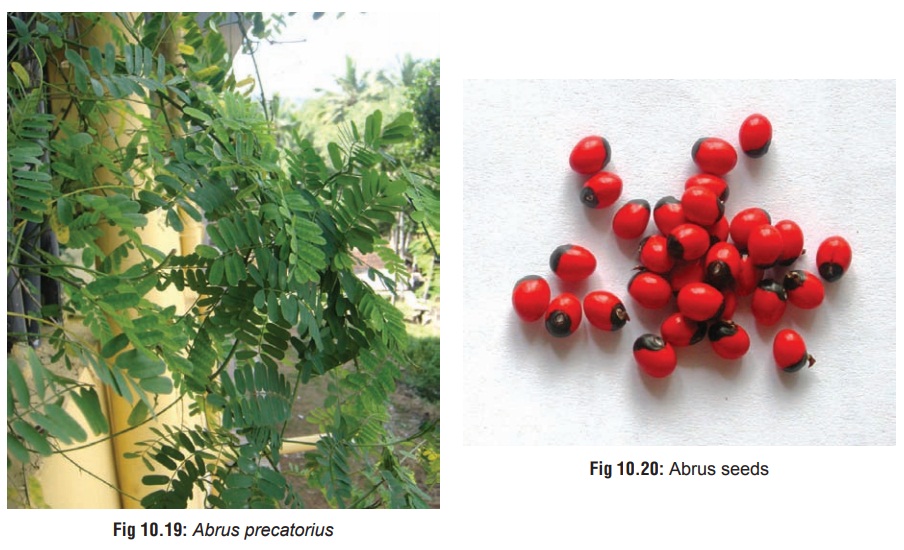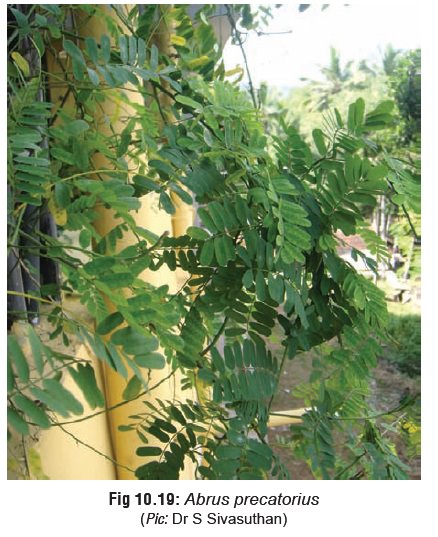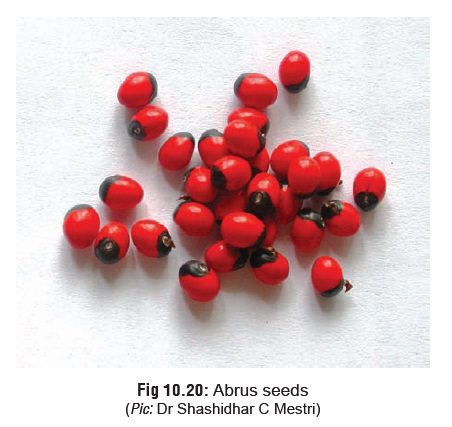Chapter: Modern Medical Toxicology: Organic Poisons (Toxins): Irritant Plants
Rosary Pea - Gastric Irritant Plants

Rosary Pea
Other Common Names
Jequirity
bean; Indian bead; Buddhist rosary bead; Rosary pea; Seminole bead; Prayer
bead; Jungle bead; Crab’s eye; Weather plant; Love bean; Lucky bean; Ojo de
pajaro; Indian liquorice.
Botanical Name
Abrus precatorius.
Physical Appearance
·
This green vine belongs to family
Leguminosae, and is a tropical, ornamental, twining, woody vine which grows to
a height of 10 to 20 feet when supported by other plants.
·
It has slender, tough branches with
5 to 10 cm long compound leaves bearing 10–20 pairs of leaflets (Fig 10.19). Leaves are alternate,
opposite, pinnately divided (feather-like) with small oblong leaflets. Leaflets
appear in 8 to 15 pairs, and are about ½ inch long.
·
Stems are green when young, but
develop grey bark as the plant matures.
·
Flowers are pink, purple, or white
and borne in clusters. They appear in the leaf axils along the stems.
· The distinctive part of the plant is the seed which is oval, 5 mm in diameter, and has an attractive hard glossy outer shell that is usually scarlet red with a black centre (Fig 10.20).*
The seeds are present inside fruit pods, each
containing 3 to 5 seeds. The pods split open when ripe. The pod is a legume
(pea-shaped pod), and is about 3 cm long.


Uses
·
The seeds are often used in rosary
beads, necklaces, and folk jewellery.
· Jewellers in India sometimes use the seeds as a weighing measure for gold or precious stones.
·
Quacks use extracts of various parts
of the plant for the treatment of a wide variety of ailments.![]()
Toxic Part
Seeds,
root, leaves.
Toxic Principles
Abrin, abric acid, glycyrrhizin, and N-methyl tryptophan.
The main active principle is abrin which is a toxalbumen very similar to ricin.
It is a lectin composed of two polypeptide chains (A and B) connected by a
disulfide bridge. This basic structure of two peptide chains linked by a single
disulfide chain is similar to that of botulinum toxin, tetanus toxin, cholera
toxin, diphtheria toxin, and insulin.
Mode of Action
Like castor, the seeds of abrus are harmless when ingested
whole, since the hard outer shell resists digestion. However, chewing or
crushing of the seed before swallowing will enable the toxins to be released.
Abrin is a powerful gastrointestinal toxin, and one of its polypeptide chains
(B) binds to the intestinal cell membrane, while the other chain (A) enters the
cytoplasm. Once in the cell, the A chain acts on the 60S ribosomal sub-unit,
preventing binding of elongation factor 2, thus inhibiting protein synthesis
and leading to cell demise.
Clinical Features
·
Dermal contact: redness, rash.
·
Ocular exposure: reddening,
swelling, blindness.
·
Ingestion:
o Burning
pain in the mouth and throat
o Severe
vomiting
o Abdominal
pain
o Bloody
diarrhoea
o Cardiac
arrhythmias
o Convulsions
o CNS
depression
o Cerebral
oedema
o Elevations
of liver enzymes.
Usual Fatal Dose
·
About 1 to 3 seeds.
·
A point to note is that there have
been several cases of inges-tion of large amounts of seeds, which have resulted
in scant clinical effects. This may reflect variations in toxicity, and/or poor
GI absorption. If the seeds of these plants are swallowed whole, symptoms are
much less likely to occur.
Treatment
·
Gastric decontamination (lavage,
charcoal).
·
Whole bowel irrigation is said to be
helpful, but some investigators dispute this.
·
Supportive measures, with special
emphasis on rehydration. Close attention should be given to haematological
parameters.
· Alkalinisation of the urine probably
has a role in preventing crystallisation of haemoglobin, and should be
considered in severe poisonings.
·
Treat convulsions in the usual
manner with diazepam.
·
Renal failure can be managed by
haemodialysis.
·
Ocular exposure necessitates copious
irrigation with running water for at least 15 minutes.
Autopsy Features
·
Evidence of GI haemorrhage,
oedematous bowel, cerebral oedema, and congested liver and kidneys.
Forensic Issues
■■ Accidental poisoning
is not uncommon among children playing in the countryside who find the seeds
very attractive and may bite or chew on them.
■■ The extract of the
seed is used in rural India to kill cattle by injecting needles (“suis”) made
out of the dried seed paste.
■■ Homicides have been
reported with “suis”.
Related Topics